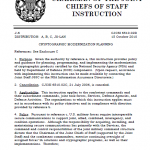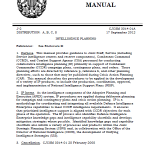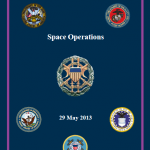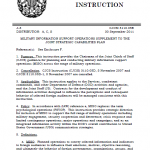
This instruction provides policy and guidance for planning, programming, and implementing the modernization of cryptographic products certified by the National Security Agency (NSA) and held by Department of Defense (DOD) components.

This manual provides guidance to Joint Staff, Service (including Service intelligence centers and reserve components), Combatant Command (CCMD), and Combat Support Agency (CSA) personnel for conducting collaborative intelligence planning (IP) primarily in support of Combatant Commander (CCDR) campaign plans, contingency plans, and orders.

This publication provides guidance for planning, executing, and assessing joint space operations. It provides space doctrine fundamentals for all joint forces; describes the military operational principles associated with support from, through, and operating in space; explains Joint Staff, combatant command (CCMD), United States Strategic Command (USSTRATCOM), and USSTRATCOM functional and Service component relationships and responsibilities; and establishes a framework for the employment of space forces and space capabilities.

In accordance with (IAW) reference a, MISO replaces the term psychological operations (PSYOP). This instruction provides strategic direction for inclusion of MISO to support the full range of military operations including military engagement, security cooperation and deterrence; crisis response and limited contingency operations; major operations and campaigns; and as an integrated information activity within the DOD’s overall contribution to United States Government (USG) communication strategies.
The purpose of operations security (OPSEC) is to reduce the vulnerability of US and multinational forces from successful adversary exploitation of critical information. OPSEC applies to all activities that prepare, sustain, or employ forces. The OPSEC process is a systematic method used to identify, control, and protect critical information and subsequently analyze friendly actions associated with military operations.
Military information support operations (MISO) play an important role in DOD communications efforts through the planned use of directed programs specifically designed to support USG and DOD activities and policies. MISO are planned operations to convey selected information and indicators to foreign audiences to influence their emotions, motives, objective reasoning, and ultimately the behavior of foreign governments, organizations, groups, and individuals in a manner favorable to the originator’s objectives. Military information support (MIS) professionals follow a deliberate process that aligns commander’s objectives with an analysis of the environment; select relevant TAs; develop focused, culturally, and environmentally attuned messages and actions; employ sophisticated media delivery means; and produce observable, measurable behavioral responses.
All modern forces depend on the electromagnetic spectrum (EMS). The military requirement for unimpeded access to, and use of, the EMS is the key focus for joint electromagnetic spectrum operations (JEMSO), both in support of military operations and as the focus of operations themselves. Electronic warfare (EW) is essential for protecting friendly operations and denying adversary operations within the EMS throughout the operational environment.
Specific guidance from the joint force commander (JFC) or higher authority during planning will determine the military deception (MILDEC) role in a joint operation. MILDEC is intended to deter hostile actions, increase the success of friendly defensive actions, or to improve the success of any potential friendly offensive action. Use of MILDEC during any phase of an operation should help to mislead adversaries as to the strength, readiness, locations, and intended missions of friendly forces. In combat situations, the focus is on driving the adversary to culmination and achieving the objectives defined by the JFC. In noncombat situations, the JFC seeks to dominate the situation with decisive operations designed to establish conditions for an early, favorable conclusion.
This publication provides joint doctrine for planning and executing counter-improvised explosive device (C-IED) operations. It outlines responsibilities, provides command and control considerations, discusses organizational options, details the C-IED process and attack the network methodology, and introduces models for coordinating with C-IED supporting organizations.
Operational experiences in Iraq and Afghanistan support the continued need to eliminate barriers to information sharing that currently exist on DoD’s multiple networks. A concerted effort to unify the networks into a single information environment providing timely information to commanders will improve command and control, thus increasing our speed of action. Providing an information technology (IT) / National Security Systems (NSS) infrastructure that is accessible anywhere and anytime is key to ensuring the agility of the Department and allowing our most valuable resources, our people, nearly instant access to the information they need to make decisions in the execution of their missions. In turn, the Global Information Grid (GIG) must be designed and optimized to support warfighting functions of advantaged and disadvantaged users, to include mission partners, across the full range of military and National Security operations in any operational environment. The GIG must also be resilient and able to support the missions despite attacks by sophisticated adversaries.
This handbook provides an understanding of the processes and procedures being employed by joint force commanders (JFCs) and their staffs to plan, execute, and assess counter threat finance (CTF) activities and integrate them into their joint operation/campaign plans. It provides fundamental principles, techniques, and considerations related to CTF that are being employed in the field and are evolving toward incorporation in joint doctrine.
This guide is designed to assist in making you and your family less vulnerable to terrorists. You should review its contents and incorporate protective measures applicable to your particular situation. It is important that you ensure all members of your family are made aware ofthis valuable information so they not only protect themselves, but also become an integral part of the overall community force protection effort. Terrorists generate fear through intimidation, coercion, and acts of violence such as bombings, hijackings, or kidnappings. As recent events have shown, terrorists have reached new levels of organization, sophistication, and violence, often targeting members of the Department of Defense and their families. Their tactics and techniques are also continually changing and will continue to be a challenge to predict and neutralize. Accordingly, we must remain vigilant.
THE PURPOSE OF THIS EXORD IS TO DELEGATE LIMITED APPROVAL AUTHORITY TO SUPPORTED COMBATANT COMMANDERS, WHO HAVE DSCA RESPONSIBILITIES, FOR ROUTINE PA REQUESTS FOR ASSISTANCE (RFA), INCLUDING THE TYPES OF RFA HISTORICALLY SUBMITTED BY PA, TO PROVIDE A RAPID AND FLEXIBLE DOD RESPONSE TO FEDERAL PRIMARY AGENCIES FOR POTENTIAL OR ACTUAL EMERGENCIES AND OR DISASTERS WITHIN THE UNITED STATES, ITS TERRITORIES, POSSESSIONS, AND PROTECTORATES.
Operation Northwoods was a plan circulated in the U.S. government in 1962 to stage false flag terrorist attacks inside the U.S. and abroad to provoke “military intervention in Cuba”. The plan called for Central Intelligence Agency (CIA) or other operatives to commit genuine acts of terrorism in U.S. cities and elsewhere. These acts of terrorism were to be blamed on Cuba in order to create public support for a war against that nation, which had recently become communist under Fidel Castro. One part of the Operation Northwoods plan was to “develop a Communist Cuban terror campaign in the Miami area, in other Florida cities and even in Washington.”
This publication has been prepared under the direction of the Chairman of the Joint Chiefs of Staff. It sets forth joint doctrine to govern the activities and performance of the Armed Forces of the United States in operations and provides the doctrinal basis for interagency coordination and for US military involvement in multinational operations. It provides military guidance for the exercise of authority by combatant commanders and other joint force commanders (JFCs) and prescribes joint doctrine for operations and training. It provides military guidance for use by the Armed Forces in preparing their appropriate plans.
The acquisition of DoD space systems results from the interaction of three complementary processes: the Joint Capabilities Integration and Development System under the authority of the Chairman of the Joint Chiefs of Staff; the Planning, Programming, Budgeting, and Execution process under the authority of the DoD Comptroller; and the NSS acquisition process under the authority of the DoD Space MDA. To work effectively, the acquisition process requires constant coordination among these processes and their authorities.
Since it would seem desirable to use legitimate provocation as the basis for US military intervention in Cuba a cover and deception plan, to include requisite preliminary actions such as has been developed in response to Task 33 c, could be executed as an initial effort to provoke Cuban reactions. Harassment plus deceptive actions to convince the Cubans of imminent invasion would be emphasized. Our military posture throughout execution of the plan will allow a rapid change from exercise to intervention if Cuban response justifies.